User:ØverLørd/Special Issue 22
Personal Notes on Special Issue 22:
Protocols for an active archive
Through SI22 protocols for an active archive we explored community radio and community archives… We made broadcasts through sound experiments, interviews and, fiction… And in prototyping we played around with forgotten media, made soundboards radio-transmitters …
highlights from SI22:
Broadcast #1
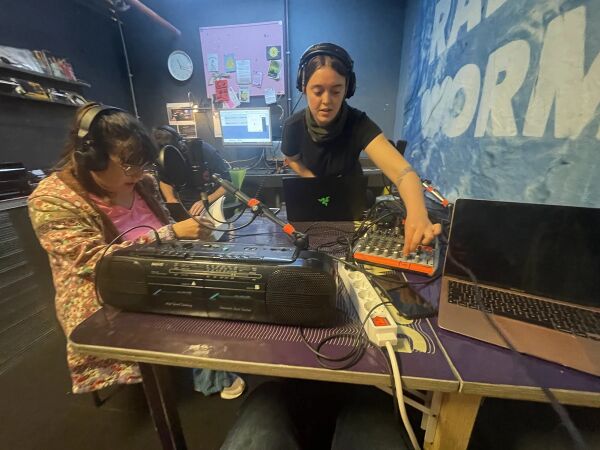
Picture from the studio @ radio worm, During the first broadcast
Initially we played a 20 minute recording by Udo from radio Aporee, where he introduces the Radio aporee project. This gave us some to to get familiar with the equipment, and set up in the studio. It also served as a nice segway into the next planned section of the show: the field recordings the group collectively made the day before.
After the recording was finished we gave a brief introduction to Xpub by reading the course description of the wiki page.
In order to activate the archive of the field recordings memory task, we used two computers and live-mixed the recordings utilizing the built in play back features of the wiki. This included changing the playback speed as well as playing different recording simultaneously. During this live-mixing-experiment another experiment was carried out in the studio: a field recording of the studio was made, which we then broadcasted.
The next segment of the broadcast, we played the pre-recorded mix-tap Riviera and Victor made the day before. We also gave a brief explanation on how the mix-tape was made.
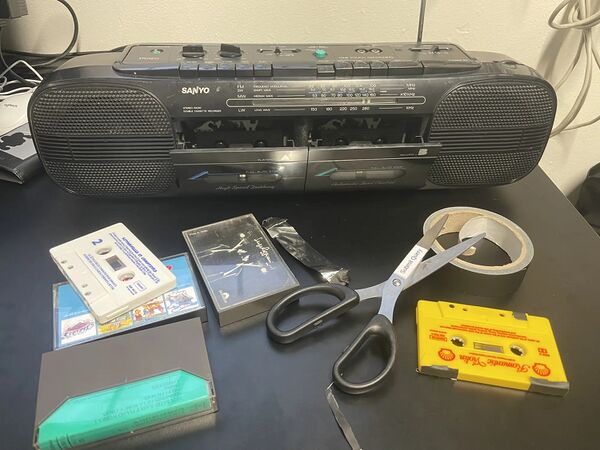
The Setup used to make the mixtape
The mixtape was made using a cassette-tape-player/recorder/radio, a box of cassette-tapes, some tape and a pair of scissors. The cassette-player have two compartments for loading cassettes. one for recording and one for playing, while recording, whatever is being played-back will be recorded on the cassette. This way it is possible to record snippets of radio, or music from other cassettes, and compile them into "sonic landscapes". One thing to note is that to record over already recorded casettes, the holes on the bottom needs to be taped over. This is a security feature to ensure that people don't accidentally ruin their favorite ABBA-tape with a weather-forecast
The relatively limited interface of the device determined the rules for what play was possible.
Some techniques that were devised during this experiment:
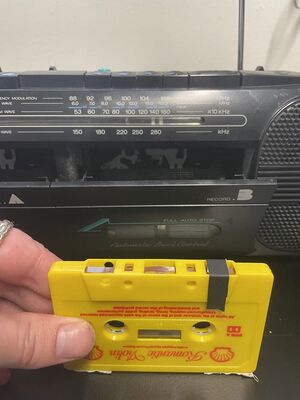
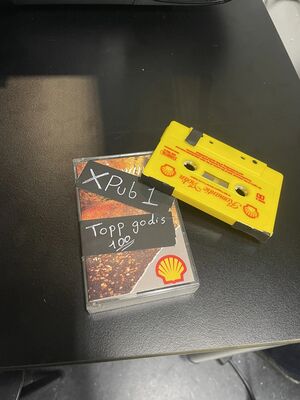
The finished mixtape, with tape covering erase head, and it's casing
In another section of the broadcast Maria read excerpts from a book, during this section we started experimenting with the different equipment we hade connected. Creating a landscape with the help of the tape-player, computer and mixing-table.
The experience of being in the studio was very interesting, with little to no experience with similar equipment the broadcast became explorative and expermental. A common theme for this broadcast could maybe be activating archives, as this was at the core of our approach. To utilize different tools to source different materials, and the play them back in various ways. Different archives activated in this session were: Radio Aporee, memory archives of the Xpub students, Old cassettes, a book, Ai jingle.generator and Youtube. Activating and iterating over different sourced materials, is a potent way of crating content, whilst also raising question regarding authorship and materiality
Personal Accounts of Irreplaceable Lace: a 200 year old history of Lost and Found
Discussions around archival practices were helpful to inform a fiction, a radio-play in three acts. Written collaboratively with Senka and Riviera, utilizing the exquisite corpse strategy. A protocol for working together, where everyone is given a limited time to work on something, and then have to pass it on to the next contestant, who shall then pickup where the initial person was cut off. This proved to be an effective strategy for generating the fiction, and with a couple of rounds of readings, writings and discussions, we had made a draft of a fiction that concerns three archivists in the same institution, in the past present and future. This resonates with the archives potential to bridge waste cases of time. Another big theme in this fiction is types of media, where we create speculative materials that questions and resonates with different aspects of the durability of archives and archived media.
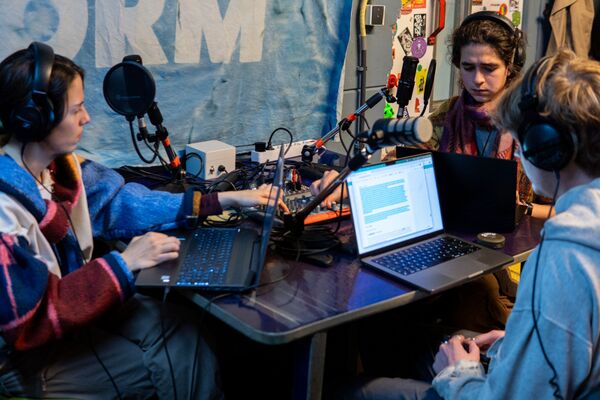
Picture from the performing of the radio-play in the studio
To allow for a collaborative process on creating the fiction we decided on a structure where we wrote multiple "diary"-entries to convey the story. To emphasize this devision some jingles to play before each entry were devised. The jingles were created audacity, cutting, stretching, tweaking and modulating sounds. The source material was a digital recording of a mix-tape tape-roll beeing wound and unwound, accompanied by "found sounds" (recorded plotter-sounds). The windings of the tape roll speak of time, and the mechanical noise of the plotter construct a curious and inventive atmosphere.
Interview with Ari
To learn more about archival practices for the SI interviews were conducted. Together with Thijs I interviewed the in-house archivist at worm, Ari. Who manage the massive archive of worm, swell as the Pirate Bay. This archive is mainly composed of different media donated by people in and around the community. In this conversation we were trying to figure out what makes an archive, and we learned that managing access is an important part of archival practices. What is the point of a sweet pokemon-card collection if nobody gets to see it right? It is in the interaction with a community an archive comes to life.
Other questions raised in the interview and in the working with the SI22 regarding archival practices were: what to archive?
When the Voyager 1 launched in 1977 it brought along a golden plate. Recorded on this golden plate is a plethora of images and sounds that intend to depict the diverse life on earth. But If anyone is to come across this record, how would they know how to read it? Or for the matter of fact even know it can be read? Luckily the eggheads at NASA thought of this and included a record player with it, as well as instructions on how to read it. (Trying to explain 70s' digital tech to aliens lol) The voyagers fate is probably one of desolation, but it raises the question about storage formats. And how it's not necessarily enough to just produce records, and take it for granted that .mp3 files is a fundamental constant that everyone will forever enjoy. In other words, archival practices also entail maintaining the knowledge and means of (re)production.
A first hand encounter with these kinds of concerns was at worm, where they work with chemical film production(?), techniques used to make blockbusters for half a century, now obsolete in the CGI-paradigm of filmmaking today. A lot of the knowledge have already been lost to time, so at worm they are experimenting in order to (re)discover the medium, whilst keeping it alive. Another aspect to the challenges of working with obsolete media is the fact that it might be hard to come by, as .com-bubble already burst and the factory is bankrupt. Thus they are not only required to maintain the knowledge of operating the equipment, but also re-invent recipes suited for the small scale laboratory that conducts this research.
On Nothingness, Un-archiving & Loss
A question that sparked some curious conversation during the interview with Ari was: How do you un-archive something? This question as well as the countless discussions regarding archival practices, and what is an archive, informed a text. A speculative essay that concerns the personal archives of ones phone-library, and then goes on to explore what loss entails. Thus it is also a homage to the "darlings killed" during the works of SI22.
Accompanying the text is a very carefully pen plotted photography, sourced from a personal phone-archive. The pen-plotted image was at some point referred to as "nothing", as the spectator could not identify the person in the tree, rendering the picture "extremely random". A reminder that one should always question "content", because in my experience there is already too much "content".
The text was featured as part of the Manual for Post-apocalyptic Radio Making, a publication that was part of the SI22.
No archive can withstand eternity. Thus archives inevitably experience loss, and the archived becomes un-archived. While this can feel unpleasant, un-archiving may be more prevalent in archival practices than at first glance. The very act of including an element in an archive, implies that said element could also not be included in the archive.
Let's imagine someone who possess smartphone. With this smartphone they like to take pictures, which they like to share with friends to reminisce about 'that one time...'
In this oversimplified scenario, the imagined someone can be understood as an archivist archiving through the process of photographic imagery. Due to physical, sociopolitical and economical limitations related to time and storage, the imagined someone is not able to archive everything. Nor does it make sense for someone to take photographs of absolutely everything with their phone, as all the memories that one would like to access, would drown in all the imagery of arbitrary moments. In other words the imagined someone is concioulsy choosing not to record everything that is not the discrete moments captured.
From this thought experiment it may be suggested that: un-archiving is just as an integral part of archival practices as the act of archiving. A potential question to ask oneself can be – What is the purpose of an archive? – It is important to stress that this question can be approached from a multiplicity of angles, as archival practices are as diverse as winter is long. One possible interpretation of the archive, is that it is a space where fragments gain context. Henceforth the parts of the archive emerge in relative structures, in which their value and utility can be understood in the context of all the other parts. If everything would be included in these relational spaces, one would loose any point of reference, thus rendering the archive useless. The lack of contents is what frames an archive, it is blank space, nothingness, which in turn suggest a silhouette of the archive. Something gives way to nothing in order for particularity to occur.
Loss on the other hand implies something else. Unlike the notion of something or nothing, loss carries a temporal connotation. Something and nothing exist only in space, whilst loss is a testimony of a past of a something transitioning into nothingness. To further explore this concept we can yet again utilize an analogy.
Imagine a someone, again, with a smartphone containing their personal archive of photographic imagery. Said phone one day becomes the unfortunate victim of gravity and in a singular moment the archive is rendered useless.
Yet again the archive is ruled by physical, sociopolitical and economical limitations and all its contents become nothing. Not only are fundamental operations such as transportation and communication impaired, but also the ability to recall the past is shattered.
The imagined someone is subjected to the partial annihilation of ones own mythos.
This frustrates them, how are they going to share their experience of a tender sunset with mere words? Their mind is doused with brief glimpses of the memories that were supposedly immortalized through the lens. In this moment of loss the imagined someone feels hurt and incomplete, yet there are also notions of relief and excitement. Parts of the past that had held them back now felt a little further away. A fresh start with the potential to grow a new archive, a more careful and intentional one. After all, the most precious moments are not forgotten, images are only empty mediators of memory and can not compare with lived experiences.
From this thought experiment we can deduct that the experience of loss can offer a moment to step back and reflect on what to hold on to. It opens up for the new and alternative, expanding the liminal between something and nothing, adding another dimension of reference. Therefore we shall reminisce on all that was lost and un-archived, as it intrinsically forms what is and what remains.
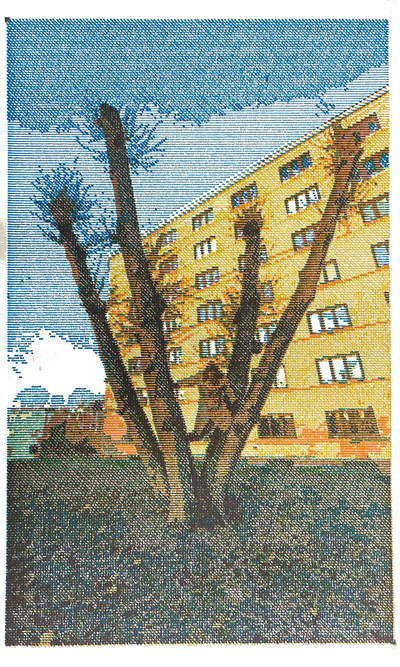
Cross hatched photography from a personal phone-library
Listen Closely
Audio spatial installation – FM transmitters and Receivers
Radio waves are agents for public commons. Resonating through communities tuning people together. they mediate through space and time disregarding borders and penetrate barriers. It can reach far beyond where any human will ever go, traveling at the speed of light towards eternity.
By organizing multiple FM transmitters in a confined space and tuning them to the same frequency, an isolated ecosphere of electromagnetic waves is induced. This choir of radio senders grow wary of the spatiality, interfering and intertwining with each other. To receive the hymn of the FM signals, equip yourself with a receiver. Let your movement in space be the interface in which you engage with the signals, and experience the proximity of the radio
So take your time, and listen closely.
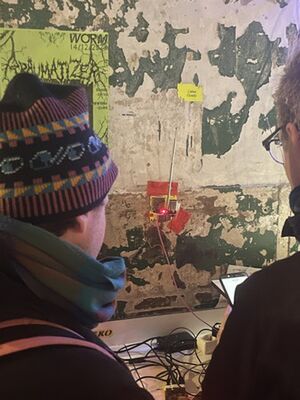
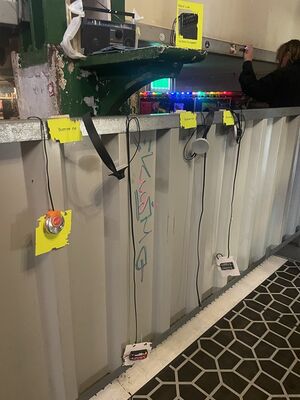
A transmitter installed at worm, and the portable radios offered at the entrance to tune in to them
The installation was part of the event at worm for the release of SI22. The event was structured around a fiction of an apocalypse. We decided collectively to formulate a metaphor as a framework for the launch-event. Through protocols for collective decision making the metaphor of apocalypse was chosen, in relation to this everyone was asked to write down a couple of thoughts on how we would envision the event, in light of the metaphor, as an exercise to get a clearer idea of what the event could be, the following is my entry:
What I imagine the SI22 would uncover is the remains of our very brief encounter with Radio worm. Abruptly in September we were introduced to this platform in order to explore protocols for active archives, and just as abruptly we are now coming to the end of this process. Through this process we have been producing, processing and consuming the contents of the worm Archive. Therefore it makes sense to highlight all these aspects of communal archiving.
Now we are facing the apocalypse and this our chance to leave seeds for the future. These seeds may be protocols along with informational artifacts that allow whoever may encounter them to revive the archive, not necessarily the specific data, but rather the semantics of its operational mode. A space where future "community members" can reflect and interact with the archive, breathing life to it. Thus confronting the idea that archives is a place where files go to die.
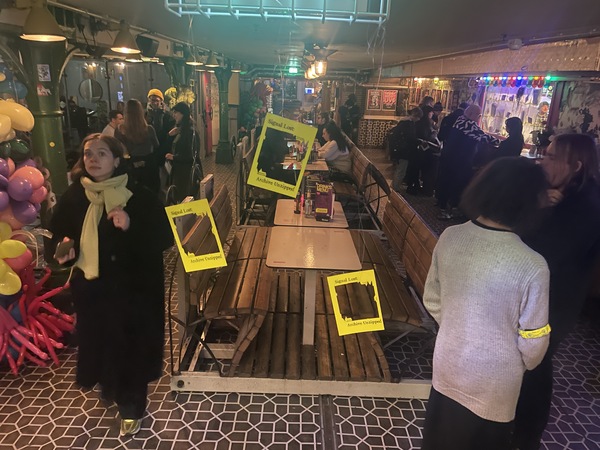
Photo from the event at worm
This project began during a lecture about amateur/pirate radio. Some of the material presented contained instructions on how to build a small portable radio transmitter. The idea was that this could be constructed from easily sourced electronic parts. As the landscape of micro-electronics has since changed, these parts are not as readily available as they once were. Fortunately it was possible to order pre-made sets containing all the components required to make a small FM-transmitter, as well as a custom PCB-board to mount them on.
So what potential lies in these small FM-transmitters? The initial idea was to set up multiple of these transmitters in the same secluded space, set them to transmit on the same frequency, this way the movement though space would determine what a "spectator" with a receiving-device set to the same frequency, would receive. In a way this turns the idea of radio on its head – as something far reaching, able to create common moments across great distance – Instead radio becomes something local and personal.
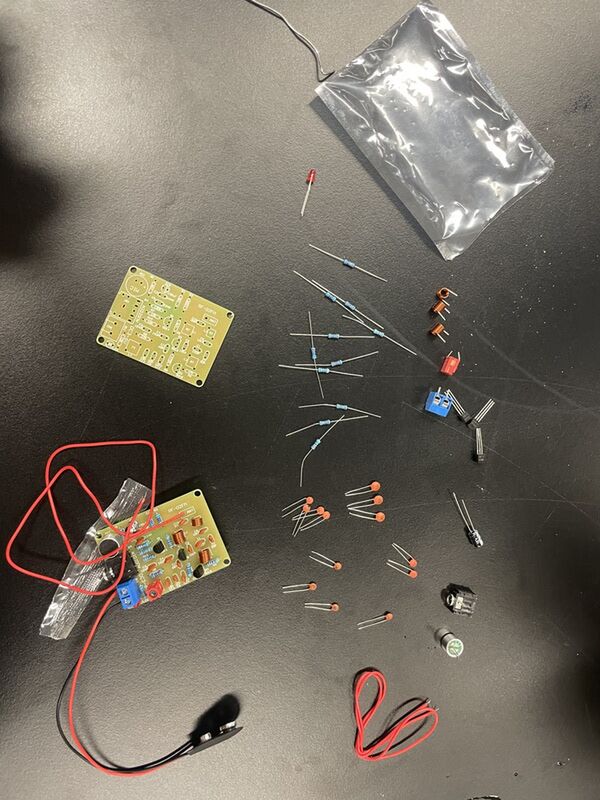
An assembled transmitter next to the unassembled components
In the time leading up to the event there was a big demand for soldering in order for the receivers and transmitters to be ready for the event. Thus what was to colloquially come to known as the factory was established. A simple space for people to engage with soldering and micro-electronics. Where you could learn the names of different components and speculate on their exact purpose.
An important lesson from working with these circuits, was that they had temper and were prone to external forces. Objects nearby the transmitters and the orientation of the antenna would affect their signal, and tuning them to the same frequency proved to be a tedious task. In order to tune them, an adjustable coil was to be adjusted. To monitor this process small handheld radios had be to carefully tuned while listening for whatever one chose to transmit.
Even a seemingly correctly soldered circuit had the potential literally go up in smoke, the "magic smoke". Magic because you only see it once, and then your thing doesn't work, the works of profound sorcery no doubt. The fragility of the circuits was further substantiated during the installation, as 2 or 3 transmitters that had worked earlier the same day, suddenly chose to produce the magic smoke.
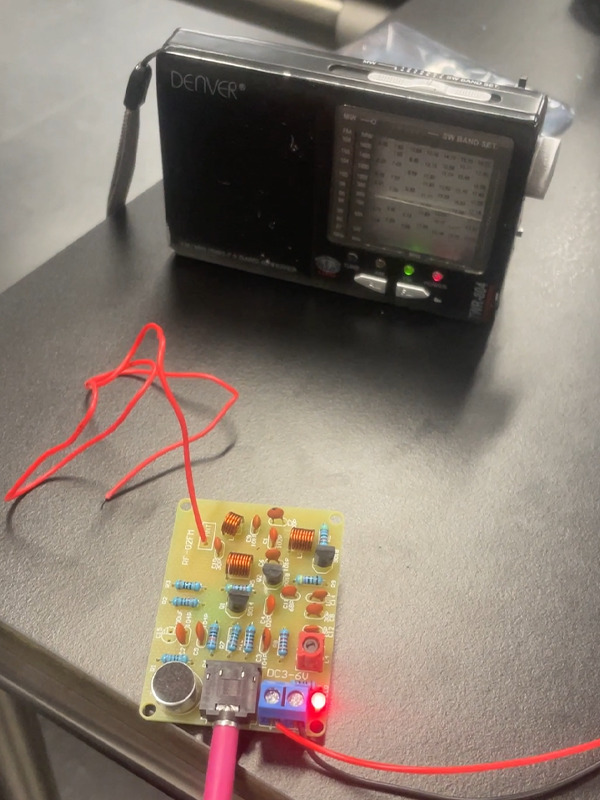
transmitter connected to audio-source and radio used to receive it
During the event we had multiple challenging factors:
- The audio interface that would connect to the transmitters was working, and then wasn't.
- The cables intended to connect the audio interface and transmitters were not shielded, therefore the signal would degrade in longer cables.
- A couple of the transmitters went up in smoke
- In general the signals from the transmitters were weak in this enviroment.
As the envisioned setup was not longer possible we made some adjustments. As the transmitters had a built in microphone, we let one of the more reliable transmitters, installed in the ceiling (that could easily be tuned in to with the supplied receivers) pick up the audio from the space and then transmit it over the FM-net. This way the project stayed true to the ideas of community radio, as the space, the collection of people, their noise was broadcasted locally.
In extension of this, the reliable transmitter was taken down from the ceiling during the broadcast (during the event). A radio tuned to the same transmitter, was handed to the caretakers in radio studio. Then the transmitter and its built in microphone was used to conduct some interviews of some participants of the event. In other words we broadcasted radio from the wunderbar into the studio which was then broadcasted on worm community radio. These interviews could also be heard by other participants at the event, creating this very intimate yet unpersonal broadcast
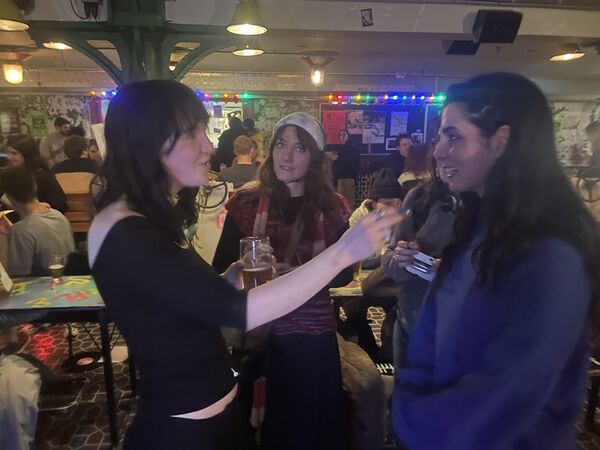
Interviewing people at the event with a radio-transmitter
fragmented recollections:
monday 18/9
This day started with a tour at worm. We got to see the different workstations, the studios and the different event spaces. The highlight of this tour was to see the radio-studio, which we were going to occupy for the following weeks. I think it is very nice that we can get introduced to the creative communities, which breathe life into the the cultural scene of Rotterdam.
When we got back to school we discussed the concept of post-digital as it is at the core of the study-programme´s philosophy and approach to art and design.
From my understanding the concept envelopes how processes and relations are mediated and conducted through a multiplicity of various channels that can be both digital, mechanical or human. Understanding these interfaces between different nodes in a network bears a lot of potential for exploration and experimention.
To further explore this concept we were introduced to a tape-recorder-and-player which could could record and was a suggested tool for creating material for our radio broadcast.
To start exploring the theme of this Special Issue we had got a small task related to field recordings. The task was to use radio aporee´s field recording archive, and find a recording that provoked a memory. Then we recorded ourselves talking about this memory in one recording, and read the meta-data of the origianl field recording in another.
Finally the task called for us to compile these three recordings in a wiki page.
This task taught us how to activate an archive, and how one can interact and iterate over information available. In this task there were multiple archives being activated: radio aporees field recording archive, our personal archive of memory, and the wiki-archive of the PZI.
Another theme of the Special Issue was discussed, the theme of protocols, therefore the group discussed different protocols for how the radio broadcast at worm could be carried out. Since our first broadcast was the following day, one of the most urgent questions was who was going to be in the studio for this first day. The group agreed that Bernadette, Maria and Victor was going to be the first group of caretakers to inhabit the Radio Worm Studio. As preparation for the first broadcast Riviera and Victor experimented with the tape-player/recorder, by covering the erase-head of the device, they were able to layer different recordings on top of each other. The different recordings collaged came from the radio, and a box of tapes from a flea marked.
Tuesday 19/9
This was the day of the first broadcast, with Bernadette, Maria and Victor as the caretakers.
Initially we played a 20 minute recording by Udo from radio Aporee, where he introduces the Radio aporee project. This gave us some to to get familiar with the equipment, and set up in the studio. It also served as a nice segway into the next planned section of the show: the field recordings the group collectively made the day before.
After the recording was finished we gave a brief introduction to Xpub by reading the course description of the wiki page.
In order to activate the archive of the field recordings memory task, we used two computers and live-mixed the recordings utilizing the built in play back features of the wiki. This included changing the playback speed as well as playing different recording simultaneously. During this live-mixing-experiment another experiment was carried out in the studio: a field recording of the studio was made, which we then broadcasted.
The next segment of the broadcast, we played the pre-recorded mix-tap Riviera and Victor made the day before. We also gave a brief explanation on how the mix-tape was made.
In another section of the broadcast Maria read excerpts from a book, during this section we started experimenting with the different equipment we hade connected. Creating a landscape with the help of the tape-player, computer and mixing-table.
The experience of being in the studio was very interesting, with little to no experience with similar equipment the broadcast became explorative and expermental. A common theme for this broadcast could maybe be activating archives, as this was at the core of our approach. To utilize different tools to source different materials, and the play them back in various ways. Different archives activated in this session were: Radio Aporee, memory archives of the Xpub students, Old cassettes, a book, Ai jingle.generator and Youtube. Activating and iterating over different sourced materials, is a potent way of crating content, whilst also raising question regarding authorship and materiality
After the broadcast we went on a visit to a gallery called Mama, where a previous Xpub student had organized an exhibition. The exhibit was focused around sensor technology and the IoT that permeates life in late-capitalist urban environments. More specifically there is a project in the makings, where the government in Rotterdam are introducing lamp posts with wifi, so they can connect to your phone and track your every move, all in the name of security and sustainability. The exhibit problematized how these technologies come with great ethical implications relating to surveillance and social control of the city´s inhabitants. It did this by framing the IoT ecosystem as this autonomous ecosystem, with trash-can clams and toy hamsters.
After the gallery visit a session in prototyping was the next up on the agenda. In this session we set up a Pi-server using ssh(I think). After creating our users and getting a brief introduction to how to communicate with the server through the terminal, we connected a line printer. This line-printer prints every line of text posted to the wall of the server. During this i printed a lot of ascii-art horses made with an online tool. It was and interesting experience in how we can collectively/collaboratively work through the server.
Wednesday 20/9
This day was dedicated to the Methods course. A course which equips us with different tools and resources that help us investigate and reflect upon our practices, through different theoretical frameworks.
The theme of this day was annotation. We were invited to develop protocols for making collective annotations. To do this we were divided into smaller groups, and each group was assigned a text which they were supposed to make annotations of.
